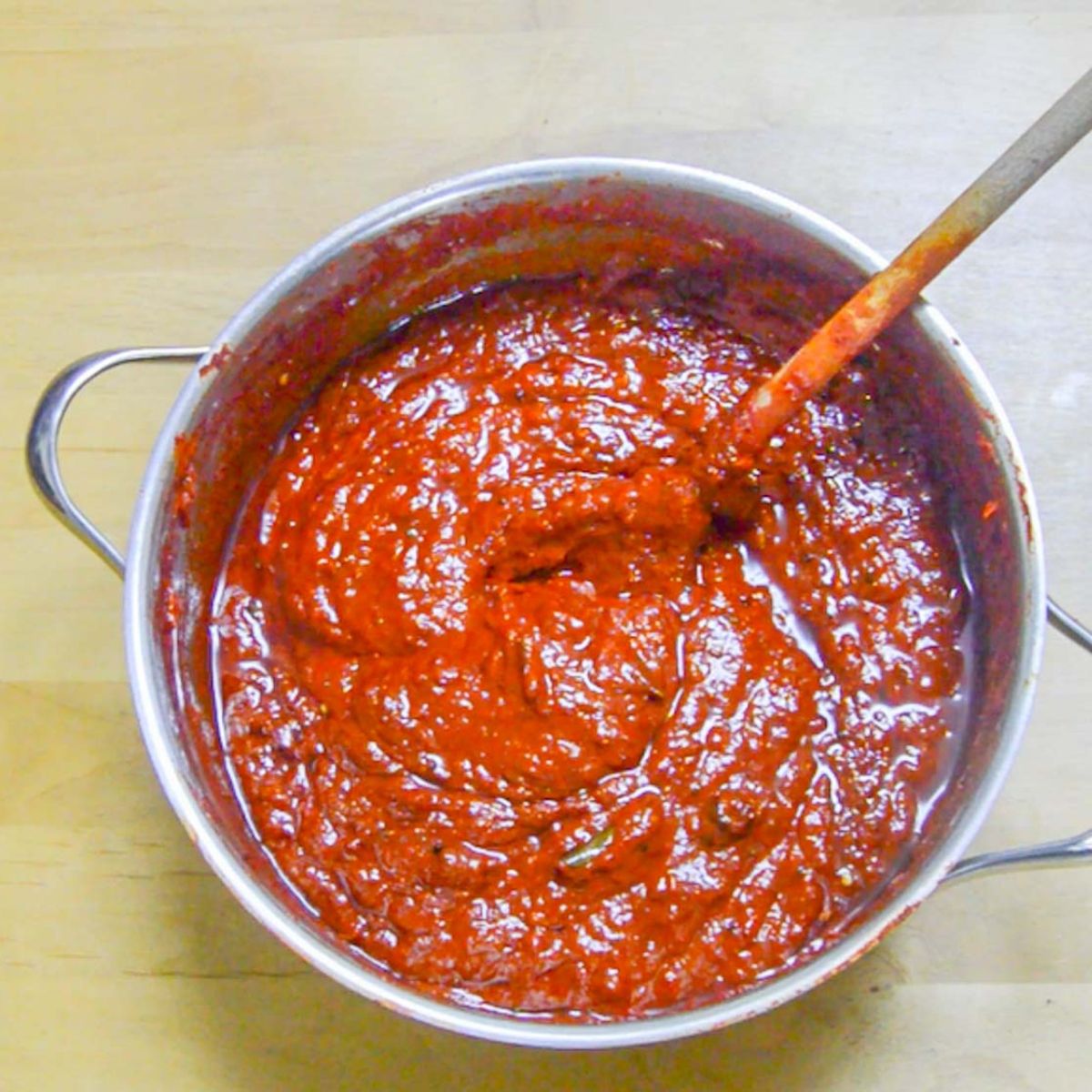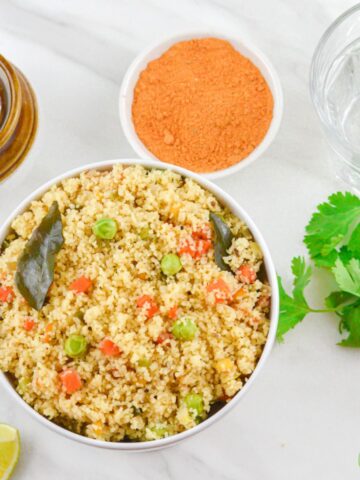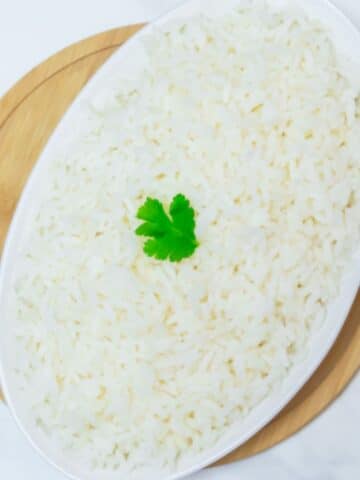Tomato pachadi - a spicy and sour authentic south Indian dish, made from fresh tomatoes, tamarind, and a handful of basic spices. Fresh tomato chutney is a beloved classic that goes well with both south Indian breakfast and main meals.

Jump to:
The word pachadi translates to accompaniment. This dish is a flavour explosion that can be enjoyed at any meal, whether it be breakfast, lunch or dinner. This is an Andhra-style tomato chutney recipe that can be stored for up to a year if kept in a dry and clean glass jar.

The tomato pachadi recipe differs in South Indian households with a unique twist. Among various versions that are time-consuming, this tomato pickle recipe is quite quick and easy, specifically for novice cooks.
The quantity I prepared will suffice for a period of 8-9 months in my house. You can scale up or down as per your requirement. Although the Andhra tomato pickle has a long shelf life, proper handling is necessary to prevent spoilage. Check out the precautions in the tips and tricks sections on this page.
Ingredients

- Vegetables: Fresh tomatoes, tamarind and curry leaves.
- Dry and Whole Spices: Mustard seeds, cumin seeds, turmeric, salt, methi (fenugreek seeds), dry red chilies and asafoetida (hing).
- Lentils: Urad dal and chana dal.
- Oil: I’ve used sunflower oil but feel free to use any neutral cooking oil.
- Red Chilli powder: I have used byadgi chilli powder that’s not extremely fiery.
Find the quantities and a short video in the recipe card at the bottom of the post.
How to make tomato pachadi?

Place the tomatoes in a wide bowl and give them a good wash with plenty of water.
Wipe every tomato with a dry cloth and put it on a tray or dry plate.
Place dry and clean steel pot on the stove.
Heat oil in the pot over medium-low heat.
Add chopped tomatoes and cook over medium-high heat while stirring regularly for 10-12 minutes or until it starts to soften.

Now add tamarind, stir regularly, and cook for 5 more minutes or until it becomes tender.
Add turmeric powder, salt and chilli powder.
Mix all the ingredients together until well combined.
Turn off the heat and let the tomato mixture cool down completely.

Meanwhile, place the frying pan and heat it over medium low heat.
Dry roast mustard and fenugreek seeds for 2-3 minutes or until they release the aroma.
Switch the heat off and let the spices cool completely.
Transfer the roasted spices to a spice jar and grind it to powder and keep it aside.

For tempering, place a skillet/pan on a stove.
Pour oil and heat it on medium-low heat.
Add mustard seeds, cumin seeds, chana dal, and urad dal to the hot oil.
Fry the spices for a couple of minutes until the dal starts to turn light brown and releases aroma.
Add red chillies followed by asafoetida and fry until a pungent aroma is released.
Add curry leaves and fry for 30 seconds and then turn the heat off.
Let it cool completely.

Transfer the cooled tomato mixture to the grinder jar and grind it into a smooth paste in batches.
Add the ground tomato chutney to a steel pot.

Add the tempered mixture and ground mustard fenugreek seeds powder to the steel pot after it has cooled.
Mix with a spoon until it is thoroughly combined with pachadi.

Preserve tomato pachadi in a glass jar.
Check out other pickle recipes on the blog - drumstick pickle (munakkaya pachadi), avakaya and allam pachadi.
Substitutions and Variations
Chilli powder: I have used byadigi chilli powder that has medium heat but you could use other varieties that are fiery hot.
Curry leaves: As fresh curry leaves were not available at the nearby grocery store, I ended up using dried ones. Fresh sprig curry leaves elevates the taste of tomato chutney. Use it if you can get it.
Garlic: Use garlic for extra flavour. Slightly crush peeled garlic and fry it with red chillies in oil.
Serving Suggestions
Tomato pachadi is a traditional accompaniment for south Indian breakfast dishes like dosa, idli, pesarattu, and upma.
This traditional condiment is a fabulous addition to Andhra thali composed of plain rice, dal, sambar, rasam, tomato mint chutney, papad, cabbage fry, yogurt, and payasam.
South Indian flavoured rice dishes like lemon rice, coconut rice, pulihora, and curd rice are perfectly complemented by this delicious tomato chutney. It is the most preferred accompaniment with flavoured rice for packed meals during travelling or long drives.

Storage
To preserve this homemade pickle for a year, store it in a clean airtight jar in a cool and dark place. Each time you serve, make sure to use a clean and dry spoon.
Keeping them in a clean and dry air-tight container in your fridge can help prolong their shelf life. Consider having a small jar of pachadi in the pantry cupboard and refill it when required. To prevent the chutney from spoiling, make sure the container is tightly sealed.
Tips and Tricks
Moisture: Always, always handle this chutney with a clean and dry spoon and hands. If not, the chutney will spoil fast. Moisture is detrimental to pickles and chutneys with long shelf life.
Mixer jar: Before placing the ingredients to grind, ensure that the mixer jar is dry.
Salt: Ensure to add the right amount of salt as it acts as a preservative and helps with the long shelf life of chutney. If you need to add less salt for health reasons, make a smaller batch and finish it sooner.
Air dry: Ensure to wipe tomatoes with a clean and dry cloth or kitchen towel. If you are unsure whether the tomatoes are wiped properly, leave the them to air dry for 3-4 hours to get rid of any moisture.
Before use, ensure the chopping board, knife, and pots are clean and free of moisture.
Tamarind: Remove the seeds and strings from the tamarind and clean them with a dry cloth or kitchen towel.
Tempering: Let it cool down before mixing it with ground chutney.
Tomatoes: Pick tomatoes that are ripe yet firm. Avoid using green or overly ripe tomatoes.
Grind the tomato mixture in batches according to the blender/grinder's capacity. Wait until it cools down completely before grinding.
Roasting spices: Let the pan heat up before roasting the spices. Roast the spices over a medium-low flame. Roasting the spices on a high flame would result in them getting burnt. Ensure the spices are completely cooled before grinding.
FAQ
The side dish pachadi is a specialty of South India. It's a generic term that has varying definitions across different regions. In Kerala and Tamil Nadu, "pachadi" refers to a yogurt-based dish, but in Andhra it means a pounded dish like pickles, condiments, and chutneys.
A layer of mold on the top is a clear sign that the pickle is spoiled and should be discarded immediately. If pickles have an unusual colour, smell, or are slimy, they are no longer good for consumption.
Yes. In fact, it is the old version andhra tomato pachadi recipe with a time-consuming process that involves soaking tomatoes with turmeric and salt for two days. The tomatoes are then squeezed and sun-dried for a day or two. Tamarind is soaked in the squeezed-out tomato liquid and then ground until smooth. Later the tamarind paste is mixed with chilli powder, salt, mustard and fenugreek powder until fully combined. The final step involves combining sun-dried tomatoes with a spiced tamarind mixture.
KEEP IN TOUCH
Do let me know if you make this tomato pachadi Andhra style. If you like this recipe kindly consider rating it using stars in the comment section or on the recipe card to help more people find this recipe online. You can stay up to date by following me on Facebook, Pinterest, Instagram or subscribing to my Youtube channel. Or why not subscribe to my blog and get simple recipes straight to your inbox?
📖 Recipe Card

Tomato Pachadi

Equipment
- 1 Mixer Grinder
- 1 Steel pot
- 2 Spoon
Ingredients
1 Cup = 250ml ; 1 Tablespoon = 15ml ; 1 Teaspoon = 5ml
- 2 kgs Tomatoes
- 3 Tablespoons (or) 34 gms Mustard
- 1.5 Tablespoons (or) 20 gms Fenugreek Seeds
- 170 gms Tamarind seeds and strings removed and cleaned
- 2 Tablespoons Turmeric Powder
- 170 gms Salt
- 200 gms Red Chilli Powder
- 100 ml Oil
- 1 Tablespoon Mustard
- ½ Tablespoon Cumin
- 1 Tablespoon Urad Dal
- 1 Tablespoon Chana Dal
- 10 Dry Red Chillies each broken into 2-3 pieces
- ½ Tablespoon Asafoetida
- Dried Curry Leaves handful
- 400 ml Oil
Instructions
- Place the tomatoes in a wide bowl and give them a good wash with plenty of water.2 kgs Tomatoes
- Wipe every tomato with a dry cloth and put it on a tray or dry plate.
- Place dry and clean steel pot on the stove.
- Heat 100ml oil in the pot over medium low heat.100 ml Oil
- Add chopped tomatoes and cook over medium-high heat while stirring regularly for 10-12 minutes or until it starts to soften.
- Add tamarind, stir regularly, and cook for 5 more minutes or until it becomes tender.170 gms Tamarind
- Add turmeric powder, salt and chilli powder.2 Tablespoons Turmeric Powder, 170 gms Salt, 200 gms Red Chilli Powder
- Mix all the ingredients together until well combined.
- Turn off the heat and let the tomato mixture cool down completely.
- Meanwhile, place the frying pan and heat it over medium low heat.
- Dry roast mustard and fenugreek seeds for 2-3 minutes or until they release the aroma.3 Tablespoons (or) 34 gms Mustard, 1.5 Tablespoons (or) 20 gms Fenugreek Seeds
- Switch the heat off and let the spices cool completely.
- Transfer the roasted spices to a spice jar and grind it to powder and keep it aside.
- For tempering, place a frying pan on a stove.
- Pour oil and heat it on medium-low heat.400 ml Oil
- Add mustard seeds, cumin seeds, chana dal, and urad dal to the hot oil.1 Tablespoon Mustard, ½ Tablespoon Cumin, 1 Tablespoon Urad Dal, 1 Tablespoon Chana Dal
- Fry the spices for a couple of minutes until the dal starts to turn light brown and releases aroma.
- Add red chillies followed by asafoetida and fry until a pungent aroma is released.10 Dry Red Chillies, ½ Tablespoon Asafoetida
- Add curry leaves and fry for 30 seconds and then turn the heat off.Dried Curry Leaves
- Transfer the cooled tomato mixture to the grinder jar and grind it into a smooth paste in batches.
- Put the tomato chutney to a steel pot.
- Add the tempered mixture and ground mustard fenugreek seeds powder to the steel pot after it has cooled.
- Mix with a spoon until it is thoroughly combined with pachadi.
- Preserve tomato pachadi in a glass jar.
Notes
Nutrition
Related
Looking for other Andhra recipes? Try these:
Pairing
These are a few dishes to serve with tomato pachadi:

Welcome to Flavours Treat. I share vegetarian recipes made with wholesome, mostly fresh ingredients. Every recipe has easy-to-follow instructions with process shots (detailed step-wise pictures), a short video and lots of tips to help your cooking journey. Read more















Leave a Reply